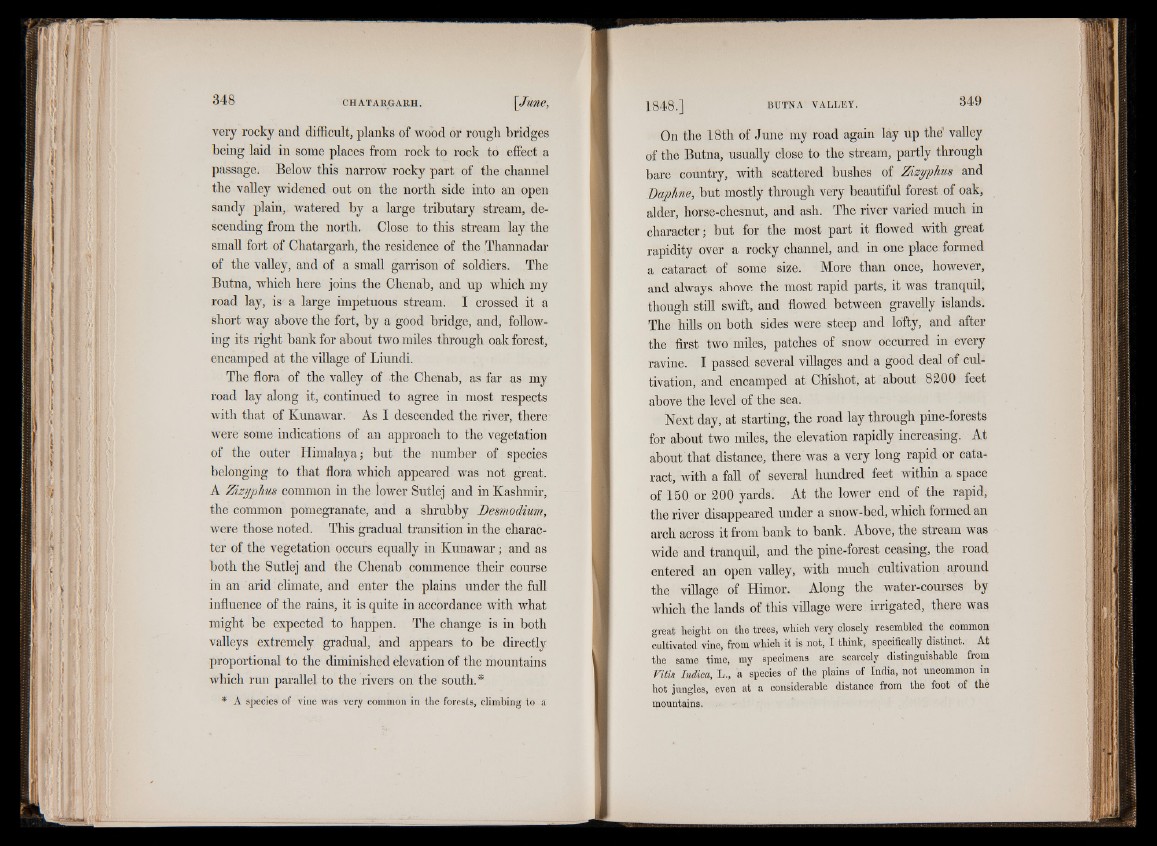
very rocky and difficult, planks of wood or rough bridges
being laid in some places from rock to rock to effect a
passage. Below this narrow rocky part of the channel
the valley widened out on the north side into an open
sandy plain, watered by a large tributary stream, descending
from the north. Close to this stream lay the
small fort of Chatargarh, the residence of the Thannadar
of the valley, and of a small garrison of soldiers. The
Butna, which here joins the Chenab, and up which my
road lay, is a large impetuous stream. I crossed it a
short way above the fort, by a good bridge, and, following
its right bank for about two miles through oak forest,
encamped at the village of Liundi.
The flora of the valley of the Chenab, as far as my
road lay along it, continued to agree in most respects
with that of Kunawar. As I descended the river, there
were some indications of an approach to the vegetation
of the outer Himalaya; but the number of species
belonging to that flora which appeared was not great.
A Zizyphus common in the lower Sutlej and in Kashmir,
the common pomegranate, and a shrubby Desmodium,
were those noted. This gradual transition in the character
of the vegetation occurs equally in Kunawar t, and as
both the Sutlej and the Chenab commence their course
in an arid climate, and enter the plains under the full
influence of the rains, it is quite in accordance with what
might be expected to happen. The change is in both
valleys extremely gradual, and appears to be directly
proportional to the diminished elevation of the mountains
which run parallel to the rivers on the south.*
* A species of vine was very common in the forests, climbing to a
On the 18th of June my road again lay up the’ valley
of the Butna, usually close to the stream, partly through
bare country, with scattered bushes of Zizyphus and
Daphne, but mostly through very beautiful forest of oak,
alder, horse-chesnut, and ash. The river varied much in
character; but for the most part it flowed with great
rapidity over a rocky channel, and in one place formed
a cataract of some size. More than once, however,
and always above the most rapid parts, it was tranquil,
though still swift, and flowed between gravelly islands.
The hills on both sides were steep and lofty, and after
the first two miles, patches of snow occurred in every
ravine. I passed several villages and a good deal of cultivation,
and encamped at Chishot, at about 8200 feet
above the level of the sea.
Next day, at starting, the road lay through pine-forests
for about two miles, the elevation rapidly increasing. At
about that distance, there was a very long rapid or cataract,
with a fall of several hundred feet within a space
of 150 or 200 yards. At the lower end of the rapid,
the river disappeared under a snow-bed, which formed an
arch across it from bank to bank. Above, the stream was
wide and tranquil, and the pine-forest ceasing, the road
entered an open valley, with much cultivation around
the village of Himor. Along the water-courses by
which the lands of this village were irrigated, there was
great height on the trees, which very closely resembled the common
cultivated vine, from which it is not, I think, specifically distinct. At
the same time, my specimens are scarcely distinguishable from
Vitis Indica, L., a species of the plains of India, not uncommon m
hot jungles, even at a considerable distance from the foot of the
mountains.